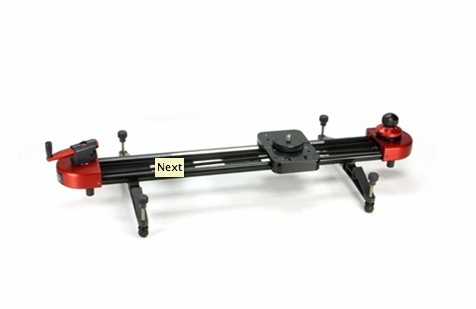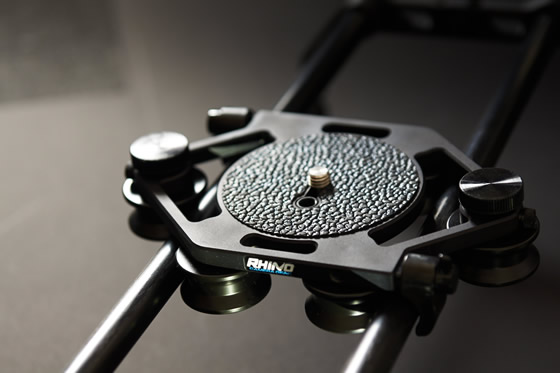aNewDomain.net — Mouths will water at NAB 2013. This year, NAB 2013 starts April 6 and runs through April 12 — in Las Vegas, of course.
Pro video peripheral makers will be showing everything from dollies and high-end trackers and sliders to the latest in camera stabilizing systems. Maybe you’re dreaming of a Kessler Crane dolly or the DitoGear modular camera slider. But if you can’t afford gear like that, there’s good news for all of you interested in time-lapse photography at the ultra high end but for a lower than ever cost.
A startup called Rhino Camera Gear is out with a pro-quality slider that costs less than $500. It was a Kickstarter hit — and lots of NAB 2013 showgoers will see it this coming week. Here’s why they’re seeing a major game changer. Camera sliders are usually paired with DSLR cameras, adding a real cinematic touch to your productions.

The 4-foot long Rhino Slider started life as a Kickstarter project. It saw instant success, pretty astonishing if you consider the crowded slider market and the overall poor quality of sub $500 gear. That’s the problem with the cheap stuff.
Take the European-made Glidetrack Hybrid HD. It, is based on the Igus system of dry gliders and rollers and uses the German synthetic, Drylin. The slider is made up of a solid aluminium rail with 1/4inch and 3/8-16inch holes drilled at regular intervals. The carriage is a heavy aluminum rectangular case inside which the Drylin gliders and rollers are seated.
The idea is that the carriage will float across the alu rail due to Drylin low-friction characteristics.
Yet options for the Glidetrack are limited to replacement parts and different rail sizes. Although the Glidetrack Hybrid HD is a fine piece of kit, some video pros have been saying they often had a bit of trouble making a really smooth glide with it. I personally tested the Glidetrack Hybrid HD for the first time over six months ago. It is true the slider occasionally hesitates. The slider can be cleaned, which helps a lot. But due to the closed carriage design, cleaning it isn’t as simple as I need it to be.
For amateurs, the Glidetrack is perfectly fine. It won’t do for pros, though. And though it breaks the $1,000 mark at about $700 for a 75cm system, it’s not cheap.
Rig Wheels is an alternative for a working slider. Rig Wheels isn’t a slider until you make it one. You buy wheels and plates, and everything else, but the rails aren’t included. Rig Wheels is nice if you love DIY.
I can go on and on writing about sliders that cost less than $500.00, but they’re all in one way or another limited in their usefulness. They either won’t work well, will only carry loads of up to an iPad’s worth, o they look more like a building project than a usable slider.
At the high end, you have companies like Kessler Crane, Cinevate and DitoGear. These companies have excellent sliders, but as they all either deliver to Hollywood or TV stations with extra deep pockets, the sliders they make and sell aren’t within realistic reach of most shooters.
That’s why the Rhino Slider is a game changer. Check out the Kessler Crane high-end offering below and scroll below the fold to see what Rhino Slider brings to the table …

Kessler Crane has the Philip Bloom series of sliders. They’re high end, but you pay for it. That particular slider, above, still costs $1,195.00. That’s why the Rhino Camera Gear approach is so interesting.
There are three models: In addition to one for light weight equipment, the Rhino Slider Carbon will carry loads of up to 10 lbs and the Rhino Slider Pro will take loads of up to 17.5kg (35lbs).
The weight/load ratio of these sliders is excellent. The Rhino Slider Pro only weighs 4.5kg.
Then there’s the design. The rails are steel or carbon fiber rods, mounted on a cleverly designed pair of feet that can be placed under any angle in order to accommodate for uneven terrain. Nothing on these sliders requires you to use any tools. You can mount, unmount, fix and remove everything by hand — and do so repeatedly without breaking the material.
The heart of the system is a hard-anodised aluminum carriage with six nylon rollers filled with 12 sealed ball bearings. Get one as a complete system or mount the carriage on any other Rhino Slider rail — that is. the short travel rails.

CEO Kyle Hart says he is proud to say this camera slider is “”made in the USA.” Rightly so. The care that went into the design of the Rhino Slider is apparent when you take a good look at the carriage.
It has two locks that you can handle with gloves on. The two preload knobs that define the drag on a slide are so small you won’t inadvertently change their setting — in addition, you can’t change the setting unless you also unscrew two larger knobs.
The tripod mounting screws and the way you can store them for switching between them is well thought out. The many tripod mounting points with each 1/4 inch hole having a companion 3/8-16 one earn high marks.
The Rhino Slider is a highly flexible system in terms of usage. For example, the entire Rhino Slider Carbon can be mounted vertically on a tripod using one of the 3/8-16 inch tripod mounts at either side. These mounts also allow you to “hang” the slider off a tripod head. The possibilities are endless.
Whatever you mount on these sliders, the ride will always be smooth. There are no hesitations, no lock-ups, no unexpected higher counter-pressure while you’re pushing or pulling the carriage during a slide.
As the carbon version weighs next to nothing, it’s also a breeze to move it around, even with all the equipment mounted. Good news also from the sound front. A noisy slider makes recording off the camera a pain. The Rhino Slider is almost completely silent, except when there is very little weight on the carriage like a GoPro.
A brilliant option for any slide that isn’t horizontal is the Slider Pulley, although a motor would be even better. This optional accessory is designed for vertical and remote shots for any model Rhino Slider. The pulley, the steel cable and the tool-less mounting screw come in a counter balance weight bag. The bag can be filled with ballast to make slides with heavier equipment easier.
Everything about the Rhino Slider has been designed with care and has been thought through to the limit. It’s basically a much more expensive system than it’s been sold for. Apparently, even the big boys think so. Rhino Camera Gear sells Rhino Sliders to the BBC and to NBC, execs say.
Now all we need is the folks at RCG to design a motor. Then they’re set to blow the competition out of the water.
See you at NAB 2013. For aNewDomain.net, I’m Erik Vlietinck.













Thank you for mentioning Kessler
sliders as a quality brand of slider. However, your categorization of our
sliders only being for high-end studios or people with “deep pockets” is not
really accurate. The Philip Bloom model is only one of our slider options
available, and has a hand polished finish, belt drive system with crank handle,
adjustable drag control for smooth consistent movements and can also be
motorized.
We have slider options for all
budget and needs. Our Pocket Dolly Basic starts at under $500 and uses the same
rail and cart system as the Philip Bloom Pocket Dolly, and is great for someone
not needing a motorized slider or is on a limited budget. Our Pocket Dolly v
2.0 starts at just over $600, has the same rail and cart system, but also
include our belt drive system with removable crank handle and can be motorized.
Our entire line of Pocket Dolly sliders support up to 15 lbs weight capacity
and our CineSlider line can support up to 80 lbs. Again, we thank you for
mentioning Kessler sliders, but want to make it clear that we do offer quality
slider solutions that are realistically priced and available to fit almost any
budget.